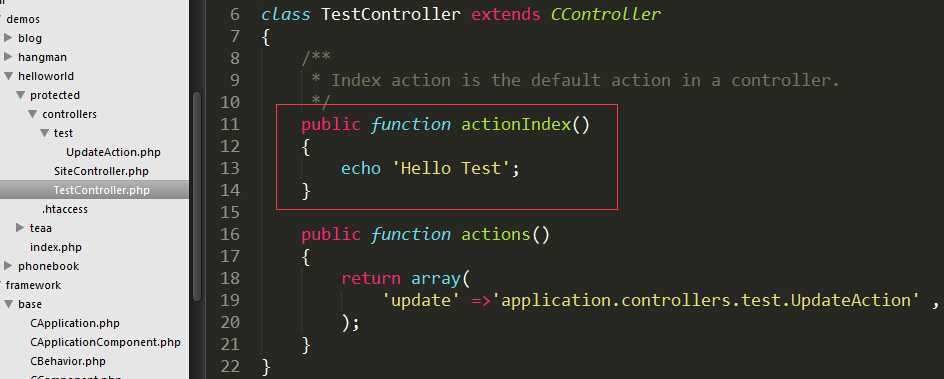标签:
前面已经看完了启动一个yii程序所要经过的流程,以及渲染一个页面是怎么完成的。今天要分析的是yii是如何处理用户请求的。也就是控制和动作部分。
还是以helloworld为例演示这一过程。我们在地址栏输入http://localhost/study/yii/demos/helloworld/index.php,页面就显示了hello world.
前面的分析都是用的默认值,但是如果url有参数的时候,yii又是怎么处理的呢?带着这个问题,我们具体来分析一下。
在CWebApplication中有这样一行代码:
$route=$this->getUrlManager()->parseUrl($this->getRequest());
这就是传说中的路由了,是不是有点小鸡冻呢?先看看getUrlManager是个神马。
public function getUrlManager() { return $this->getComponent(‘urlManager‘); }
这个又要通过找关系了.
public function getComponent($id,$createIfNull=true) { if(isset($this->_components[$id])) return $this->_components[$id]; elseif(isset($this->_componentConfig[$id]) && $createIfNull) { $config=$this->_componentConfig[$id]; if(!isset($config[‘enabled‘]) || $config[‘enabled‘]) { Yii::trace("Loading \"$id\" application component",‘system.CModule‘); unset($config[‘enabled‘]); $component=Yii::createComponent($config); $component->init(); return $this->_components[$id]=$component; } } }
执行了return $this->_components[$id]; id就是传进去的urlManager,其实从这里也还看不出什么,直接找到urlManager这个类,看parseUrl:
public function parseUrl($request) { if($this->getUrlFormat()===self::PATH_FORMAT) { $rawPathInfo=$request->getPathInfo(); $pathInfo=$this->removeUrlSuffix($rawPathInfo,$this->urlSuffix); foreach($this->_rules as $i=>$rule) { if(is_array($rule)) $this->_rules[$i]=$rule=Yii::createComponent($rule); if(($r=$rule->parseUrl($this,$request,$pathInfo,$rawPathInfo))!==false) return isset($_GET[$this->routeVar]) ? $_GET[$this->routeVar] : $r; } if($this->useStrictParsing) throw new CHttpException(404,Yii::t(‘yii‘,‘Unable to resolve the request "{route}".‘, array(‘{route}‘=>$pathInfo))); else return $pathInfo; } elseif(isset($_GET[$this->routeVar])) return $_GET[$this->routeVar]; elseif(isset($_POST[$this->routeVar])) return $_POST[$this->routeVar]; else return ‘‘; }
从上面的代码来看,如果我们不在url上传点东西,直接就return ‘‘了。于是问题来了,参数要怎么传呢?
isset($_GET[$this->routeVar])
public $routeVar=‘r‘;
于是有办法了,让我们一起来使点坏吧。加上这样的一个参数helloworld/index.php?r=abc

发现报错了。说明abc这个控制器是不存在的,事实上也是不存在的,使点小坏坏而已,正所谓男人不坏,女人不爱。
改成helloworld/index.php?r=site就可以显示hello world了,这是什么鬼原理呢?原因很简单,因为定义了site控制器嘛。
class SiteController extends CController { /** * Index action is the default action in a controller. */ public function actionIndex() { echo ‘Hello World‘; } }
好吧,这个我没有意见,但是actionIndex又是神么鬼?在yii中,这称为动作。它捕获的是控制器后面的参数,如果我们输?r=site/index就是index,动作是用“/"进行分隔的,为了验正一下我说的不是骗女孩子的鬼话,我在site控制器里加一个动作给你看一下:
class SiteController extends CController { /** * Index action is the default action in a controller. */ public function actionIndex() { echo ‘Hello World‘; } public function actionView() { echo ‘Hello View‘; } }
访问?r=site/view的时候,是不是看到输出‘Hello View‘了呢?肯定是的,虽然我读的书少,但是你骗不了我的,有图有真相:

我一点儿也不喜欢用site这个名字,test才是我的最爱,于是我又建了一个test控制器来尝试一下。


眼尖的一定看到怎么写了一个actions,这是什么鬼?我也是刚试了才知道,它其实是另一种表示方式。
我记得在blog那个例子中有用过,用来显示验证码:
/** * Declares class-based actions. */ public function actions() { return array( // captcha action renders the CAPTCHA image displayed on the contact page ‘captcha‘=>array( ‘class‘=>‘CCaptchaAction‘, ‘backColor‘=>0xFFFFFF, ), // page action renders "static" pages stored under ‘protected/views/site/pages‘ // They can be accessed via: index.php?r=site/page&view=FileName ‘page‘=>array( ‘class‘=>‘CViewAction‘, ), ); }

我把它理解为集中声明第三方业务的动作集合,因为本控制器内的动作,我觉得还是action+ID 的方式直接。
什么鬼?你说我用的是index.php/site/captcha 而不是index.php?r=site/captcha .这又得从配置文件说起。
‘urlManager‘=>array( ‘urlFormat‘=>‘path‘, ‘rules‘=>array( ‘post/<id:\d+>/<title:.*?>‘=>‘post/view‘, ‘posts/<tag:.*?>‘=>‘post/index‘, ‘<controller:\w+>/<action:\w+>‘=>‘<controller>/<action>‘, ), ),
urlFormat 有path 和 get两种,如果在main.php中没有指定,那么就是get方式,也就是index.php?r=site/captcha这种。如果指定了,即index.php/site/captcha这种
从字面上也很好理解,path就是像路径的格式,get就是?这种形式。
关于路由和控制器部分的内容还有很多,但是本节就到这里了。
标签:
原文地址:http://www.cnblogs.com/afrog/p/4177824.html